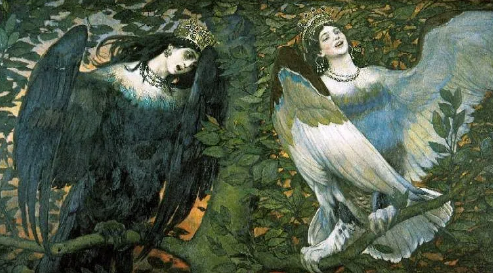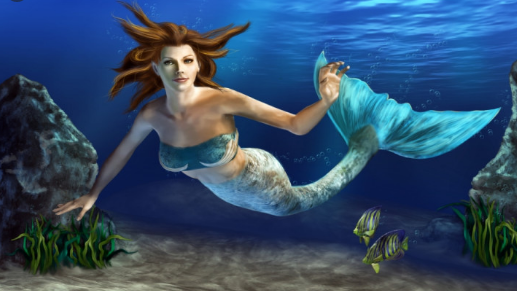Often used interchangeably or confused due to their aquatic associations, sirens and mermaids are different mythological entities with unique characteristics and symbolism. Get to learn about Sirens and Mermaids in the context of their origins, appearances, behaviors and their impact on literature, art and popular culture.
Remember that interpretations of these mythological creatures can be different depending on cultural and artistic contexts, and therefore their depictions and characteristics can as well be different.
What Are Sirens?
Sirens, in mythology and folklore are enchanting and dangerous creatures. They are usually depicted as beautiful women with the lower bodies of birds. Their most well-known characteristic is their alluring and irresistible singing voices, which they would use to lure sailors to their doom. Sirens would perch on rocky shores or islands, singing hauntingly beautiful songs that would draw sailors and their ships towards them.

In early Greek art, they were represented as birds with large women’s heads, bird feathers and scaly feet. Later, they were represented as female figures with the legs of birds, with or without wings, playing a variety of musical instruments, especially harps and lyres. Eventually, they came to be depicted as only dangerous beautiful women with the wings of a bird. The story of Sirens has inspired writers, poets and artists for millennia. Many associate Sirens with hidden knowledge.
In Greek mythology, the most famous reference to Sirens comes from Homer’s “Odyssey.” In this epic poem, the hero Odysseus and his crew encounter the Sirens while on their journey back home after the Trojan War. Heeding the advice of the sorceress Circe, Odysseus has his men plug their ears with beeswax so they cannot hear the Sirens’ song. Curious to hear the music himself, Odysseus has himself tied to the mast of the ship so he can experience the Sirens’ enchanting melodies without succumbing to their allure and driving the ship off course.
The concept of Sirens has been revisited and reimagined in many literary works, artworks and cultural contexts throughout history. They continue to symbolize the dangers of seduction and the power of distraction. In modern times, the term “siren” is often used metaphorically to refer to any kind of captivating or enticing allure that can lead people astray from their intended goals or paths.
What Are Mermaids?
Mermaids are mythical creatures that combine the features of humans and fish. They are usually depicted as having the upper body of a woman and the lower body of a fish. They portrayed as elegant and ethereal, with a mesmerizing charm that draws humans near. These beings have captured the imagination of cultures around the world for centuries. In some variations, mermaids are said to have the ability to shape-shift between human and fish forms.
They appear in folklore, literature, art and many cultures worldwide including the Near East, Europe, Asia and Africa. For instance, in ancient Assyrian mythology, there were stories of goddesses such as Atargatis and Ishtar who had fish-like attributes. In Scandinavian folklore, the “selkie” was a seal that could transform into a human form, akin to the mermaid motif.
Mermaids are sometimes associated with perilous events such as floods, storms, shipwrecks and drowning. In other folk traditions they can be benevolent or beneficent, bestowing boons or falling in love with humans. A famous Greek folktale claimed that Alexander the Great’s sister, Thessalonike was transformed into a mermaid upon her death in 295 BC and lived in the Aegean Sea.
Another earliest references is the ancient Assyrian goddess Atargatis, who unintentionally transformed herself into a fish-like being to escape a mortal lover’s advances. In European folklore, mermaids were often associated with sailors and the sea. Tales would tell of mermaids sitting on rocks, combing their hair and singing captivating songs to lure sailors to their deaths.

In some ancient texts, Mermaids appear not alone but in a group of two or three and not only in the water but sitting on reefs waiting for the arrival of ships. All these stories were used as cautionary tales, warning sailors of the dangers of the sea and the allure of the unknown.
Today the images that represent mermaids are the ones of ladies of waters, very beautiful and showing provocative gestures to those who glimpsed at them.
Historical accounts of mermaids, such as those written by Christopher Columbus during his exploration of the Caribbean, have been discountenanced by many scholars as sightings of similar aquatic mammals. Though there are few accounts here and there by some people of mermaid sightings that continue up to present day, there is no evidence that mermaids exist outside folklore.
Also Read: Difference Between Pixie And Fairy
Siren vs Mermaid: Key Differences
Origin and Mythology
- Sirens: In Greek mythology, sirens were dangerous creatures, often depicted as half-bird and half-woman. They lured sailors to their deaths with enchanting songs and voices.
- Mermaids: Mermaids, on the other hand, are creatures found in various mythologies around the world. They are typically portrayed as half-human and half-fish and are often associated with beauty, mystery, and occasionally benevolence.
Physical Appearance
- Sirens: Sirens were usually depicted with the bodies of birds, featuring wings, feathers, and sometimes claws. Their faces may have been human-like or bird-like.
- Mermaids: Mermaids have the upper body of a human and the lower body of a fish. They usually have human-like features, often with long hair and captivating eyes.
Nature and Behavior
- Sirens: Sirens were known for their dangerous and seductive nature. They used their enchanting voices to lead sailors to their deaths by causing ships to crash on rocky shores.
- Mermaids: Mermaids are commonly seen as more benevolent. While some myths attribute them with luring sailors, many portray them as curious and gentle beings who might aid or warn sailors.
Voice and Song
- Sirens: The captivating voices of sirens were their primary tool for luring sailors. Their songs were so enchanting that sailors could not resist following the sound, leading to their demise.
- Mermaids: Mermaids are not as strongly associated with using their voices to lure sailors. Instead, their songs might be soothing or melancholic, expressing their longing for the human world.
Symbolism
- Sirens: Sirens symbolize danger, temptation, and the perils of succumbing to one’s desires.
- Mermaids: Mermaids are often seen as symbols of femininity, allure, and the unknown depths of the ocean.
Cultural Variations
- Sirens: Sirens are predominantly found in Greek mythology, although similar creatures appear in other cultures as well.
- Mermaids: Mermaids appear in the myths of various cultures, including those of Europe, Asia, Africa, and the Americas.
Literary and Artistic Representations
- Sirens: Sirens are frequently depicted in ancient Greek art, literature, and epic poems like Homer’s “The Odyssey.”
- Mermaids: Mermaids have been portrayed in literature and art across different time periods, often as romantic and fantastical figures.
Pop Culture Impact
- Sirens: Sirens continue to influence modern media with their portrayal as dangerous and mesmerizing creatures, often appearing in fantasy novels, movies, and TV shows.
- Mermaids: Mermaids have gained widespread popularity, often depicted as more positive and magical beings in movies, children’s stories, and animations.
Association with Water
- Sirens: Sirens were not exclusively associated with water; their presence could be found near dangerous coastal areas.
- Mermaids: Mermaids are closely tied to aquatic environments, inhabiting oceans, seas, lakes, and rivers.
Historical Perception
- Sirens: In historical context, sirens were feared for their destructive capabilities and were seen as a cautionary tale for sailors.
- Mermaids: Throughout history, mermaids have been both feared and admired, with their allure capturing human imagination and inspiring stories of love and adventure.
Siren vs Mermaid: Key Takeaways
| BASIS OF COMPARISON | SIREN | MERMAID |
| Synonyms | Enchantress, charmer, sorceress or vamp. | Water nymph, elf, kelpie or water deities. |
| Presence | Only found in the Greek Mythology. | They are found in the folklore and stories of all cultures and civilization. |
| Habitat | The Siren is depicted to be an island creature. | Mermaid is depicted as an aquatic creature. |
| Depiction | The Sirens are depicted as beautiful and evil maidens. | Mermaids are usually depicted as peaceful, non-violent creatures that try to live their lives away from human interference. |
| Body Structure | The Sirens are actually winged, half-human, half-bird creatures. | They have the head and the upper body of a female human and the tail of a fish. |
| Use | Siren mostly makes an appearance in art where negativity and horror is the theme. They are therefore not suitable for children. | Mermaids have their representation in modern culture as beautiful and loving creatures. They are suitable for kids. |
| Attraction | Sirens attract people with their voice. | Mermaids show their love towards people. They also entice people with their beauty looks. |
| Luring Of Sailors | In all folktales, the Sirens are known for luring sailors to their deaths. | Mermaids are depicted differently in different cultural folklores, in some folklore they are depicted as gentle, benevolent and peace-loving while in other folklores they are shown to be luring sailors to their death. |
| Famous Folklore | A famous Greek folktale claimed that the Sirens were fated to die if any mortal should hear them sing and live to tell the story. | A famous Greek folktale claimed that Alexander the Great’s sister, Thessalonike was transformed into a mermaid upon her death in 295 BC and lived in the Aegean Sea. |
Also Read: Difference Between Thunder And Lightning